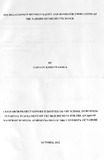| dc.description.abstract | The objective of this study was to establish the relationship between yields on bonds and
returns on equities at the NSE from January 2002 to September 2012. The study employed
the NSE 20 share index and the yields on 1-year and 2-year bonds over the sample period.
Data was analyzed for stationarity before applying correlation analysis and regression
analysis. The results indicated that the NSE index is nonstationary and integrated of order
one while yields on bonds were stationary. Hence, in this study yields on bonds were
regressed on the differenced NSE-20 index series. The results show that there is a negative
relationship between the growth rate in the NSE-20 index and the yields on bonds. However,
there is a positive relationship between the differenced NSE-20 index growth rate and the
yields on bonds. Further, yields exert a significant positive impact on the variability in the
growth rate of the NSE-20 Index.
In conclusion, holding bonds and equities in the same portfolio constitutes a good
diversification strategy. First, the two assets are negatively correlated. Moreover, changes in
bond yield tend to increase returns on equities. Thus, the benefits of holding bonds and
equities in a portfolio are higher returns at a lower risk. | en |

